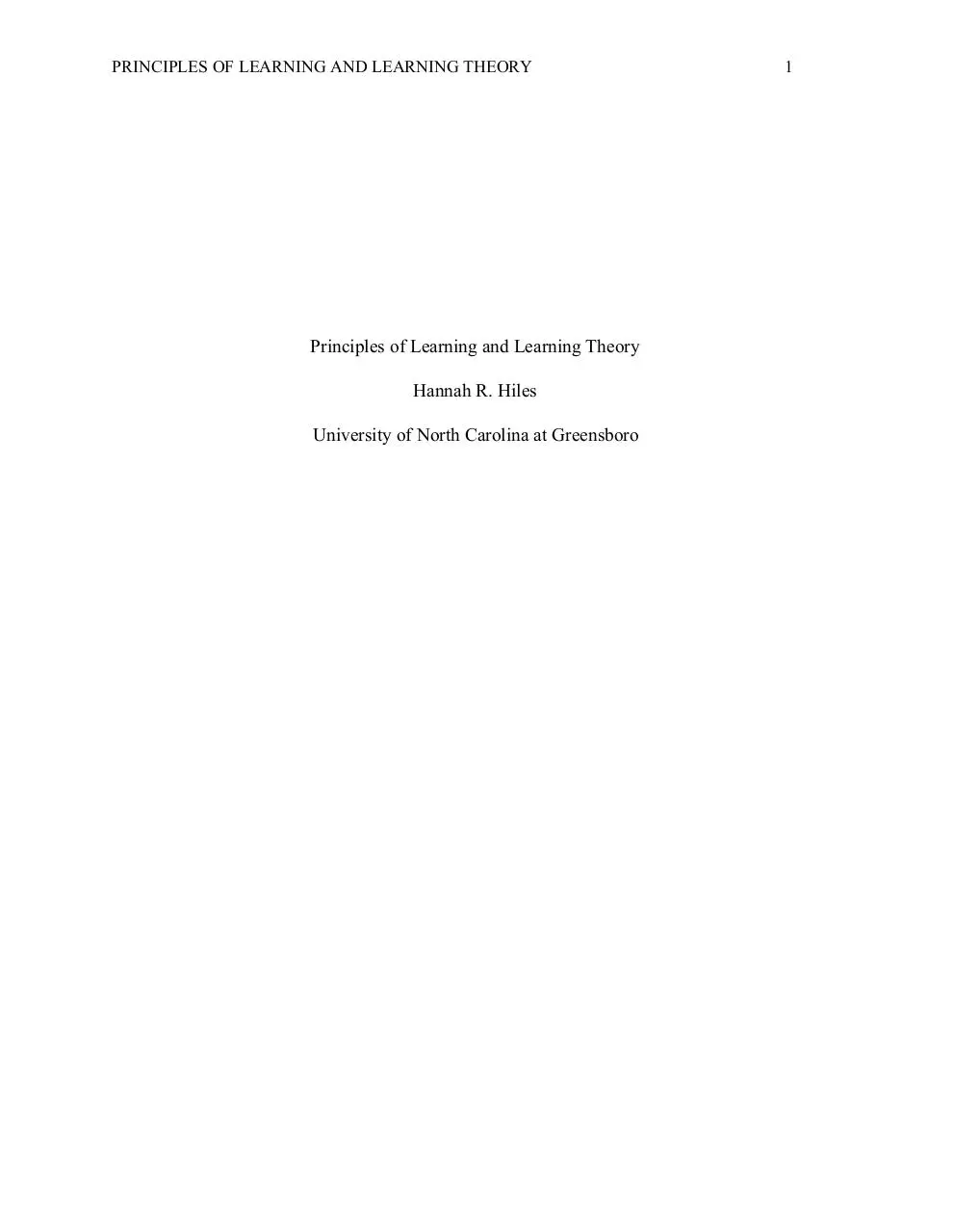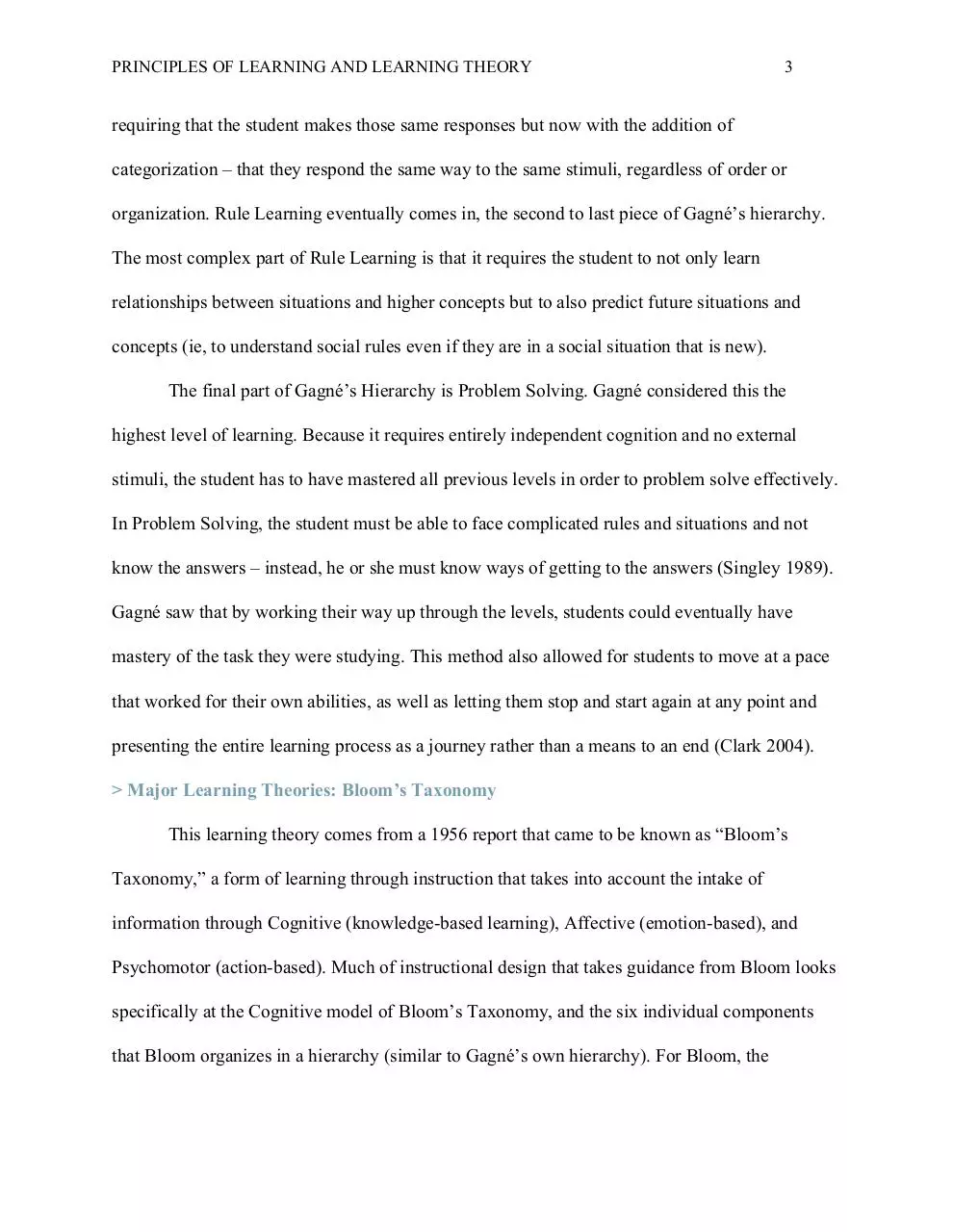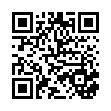PrinciplesofLearningandLearningTheory (PDF)
File information
This PDF 1.5 document has been generated by / Skia/PDF m52, and has been sent on pdf-archive.com on 24/04/2016 at 03:41, from IP address 24.211.x.x.
The current document download page has been viewed 719 times.
File size: 233.65 KB (15 pages).
Privacy: public file





File preview
PRINCIPLES OF LEARNING AND LEARNING THEORY
Principles of Learning and Learning Theory
Hannah R. Hiles
University of North Carolina at Greensboro
1
PRINCIPLES OF LEARNING AND LEARNING THEORY
2
What is learning?
> Major Learning Theories: Gagné’s Hierarchy
Much of our understanding of education and the teaching process comes from Robert
Gagné, an early 20thcentury experimental psychologist who was primarily interested in learning
and instruction. It was Gagné who gave us the most fundamental basis for the process of
teaching and what the instruction process looks like. Gagné’s Hierarchy of Learning presents
eight ways to learn, with each stage building on the lower levels, ensuring that the upper levels
require greater skill and ability to conquer.
From the bottom up they begin with Signal Learning. As it is at the very bottom of the
hierarchy it is part of Pavlov’s “classical conditioning,” or the act of conditioning a subject to
provide a desired response in conjunction with a predetermined signal. Next comes
StimulusResponse Learning – a more advanced version of classical conditioning. It incorporates
the use of schedules and rewards in the learning process. Chaining comes next, wherein a student
begins to learn the ability to connect prior lessons together in an organized sequence. After
Chaining comes Verbal Association. A higherlevel form of Chaining, Verbal Association is the
same idea, but with those prior lessons being vocal in nature as opposed to physical. Note that
only halfway up the hierarchy, we are finally at a point where the student is at a point where they
are beginning to incorporate verbal skills – the magnitude of Gagné’s hierarchy and just how
“basic” his most fundamental lessons are cannot be overstated.
Discrimination Learning, Concept Learning, and Rule Learning are next and are very
linked together. Discrimination Learning is the process of a student being able to form
appropriate responses in an organized and precise way. Concept Learning follows this by
PRINCIPLES OF LEARNING AND LEARNING THEORY
3
requiring that the student makes those same responses but now with the addition of
categorization – that they respond the same way to the same stimuli, regardless of order or
organization. Rule Learning eventually comes in, the second to last piece of Gagné’s hierarchy.
The most complex part of Rule Learning is that it requires the student to not only learn
relationships between situations and higher concepts but to also predict future situations and
concepts (ie, to understand social rules even if they are in a social situation that is new).
The final part of Gagné’s Hierarchy is Problem Solving. Gagné considered this the
highest level of learning. Because it requires entirely independent cognition and no external
stimuli, the student has to have mastered all previous levels in order to problem solve effectively.
In Problem Solving, the student must be able to face complicated rules and situations and not
know the answers – instead, he or she must know ways of getting to the answers (Singley 1989).
Gagné saw that by working their way up through the levels, students could eventually have
mastery of the task they were studying. This method also allowed for students to move at a pace
that worked for their own abilities, as well as letting them stop and start again at any point and
presenting the entire learning process as a journey rather than a means to an end (Clark 2004).
> Major Learning Theories: Bloom’s Taxonomy
This learning theory comes from a 1956 report that came to be known as “Bloom’s
Taxonomy,” a form of learning through instruction that takes into account the intake of
information through Cognitive (knowledgebased learning), Affective (emotionbased), and
Psychomotor (actionbased). Much of instructional design that takes guidance from Bloom looks
specifically at the Cognitive model of Bloom’s Taxonomy, and the six individual components
that Bloom organizes in a hierarchy (similar to Gagné’s own hierarchy). For Bloom, the
PRINCIPLES OF LEARNING AND LEARNING THEORY
4
hierarchy comes in the form of Remembering, Understanding, Applying, Analyzing, Evaluating,
and Creating.
It’s important when looking at Bloom’s hierarchy to see that, as with Gagné, each step
leads to the next. The student begins with remembering materials – they can recall and repeat
facts and answers from their longterm memory with ease. Once they can remember information
they can proceed to understand it – one can memorize sums and figures or dates in history
without actually understanding what they mean, but Bloom saw this second level of
Understanding as an important moment in the educational process.
Applying is the student’s use of the information they have come to understand – this will
vary depending on the information they have, but the more they use the information at hand, the
deeper their understanding of it will come. This leads directly into Analyzing, where a student
can look at the work they are doing (their “application” in the previous state of the hierarchy)
and determine cause and effect. This work of analyzing their lesson moves organically into
Evaluating – if A causes B, and B is a problem, how can the student solve B? This stage of
Evaluation is similar to Gagné’s final level of Problem Solving – it is the process of a student
looking for the work they are doing and determining where the issues are, then finding for
themselves what the solutions may be.
Finally, the student can move into Creating. Unlike Gagné, Bloom didn’t see the
educational process as stopping at Problem Solving – for him, the pinnacle of mastering a skill or
learning something new came when the student was able to then take that information and do
something unique with it. Bloom’s first edition of the Taxonomy had this final stage as
“Knowledge,” but in 2001 (two years after his death), it was updated to “Creating” or
PRINCIPLES OF LEARNING AND LEARNING THEORY
5
“Synthesizing”. This is the student’s ability to take unique and individual parts and put them
together into a larger and more unified representation of the lesson or information they have been
learning – a synthesis of their learned knowledge (Wineburg 2009).
> Major Learning Theories: Behaviorism, Cognitivism, and Constructivism
Behaviorism, Cognitivism, and Constructivism are three additional members of learning
theory that cannot be neglected. Going back to Gagné’s “signal learning” and Pavlov’s “classical
conditioning,” Behaviorism looks at the most simple behavioral changes in an organism. As
Jordan et al point out, Behaviorists are quick to defend that they don’t believe learners don’t
think, rather “they [researchers] mainly choose to ignore inaccessible mental processes and focus
on observable behaviour” (2008). Cognitivism is a step up, branching into the mental processes
of how we observe and then process our environments and what happens to us. While
Behaviorism may be the kneejerk reactions, Cognitivism in learning relies on “developing
effective ways of building schemata and processing information” (Jordan). Finally, in
Constructivism, we see yet a further advancement in the realm of cognition. Instead of simply
processing information as in Cognitivism, Constructivism is a school which is based on the
educator taking a passive role in their pupil’s learning – instead of dishing out answers, they may
use questions to inspire their students to probe deeper into their own understanding of the
materials, and find their own answers within. Jordan et al note that while the flow between
Constructivism and Cognitivism can be difficult to differentiate, Constructivism ultimately
“focuses on what people do with information to develop knowledge” (2008).
PRINCIPLES OF LEARNING AND LEARNING THEORY
6
> Cognition and Memory
The roles of cognition and memory in the learning process cannot be overstated. After all,
if there is any purpose behind instruction, it is with the end goal of the student to learn and
remember. Our memory develops through three stages, our sensory memory, our working
“shortterm” memory, and our longterm memory. When a student is involved in an ongoing
instruction or lesson, their working memory is holding onto the information that comes to them
through their sensory memory as their minds work to sort through the information – Gathercole
describes working memory as a “mental workspace that we can use to store important
information in the course of our mental activities” (2007). It is in the stages of short term
memory that students repeat information and get into the actions of “behaviorisms” or repetition
that help make the educator’s lesson stick, thereby moving the information into their long term
memory. Once there, the information can be more easily retrieved during the next lesson while
the student works to make comparisons, form new ideas, and challenge themselves with the
materials at hand.
What is Teaching?
> Instructional Process
By referencing both Gagné and Bloom, we can form an idea of what the instructional
process should look like. Instruction must begin with establishing learning outcomes for the
students, and identifying any of the needs of both the instructor and the students before
instruction can begin (environmental needs, material needs, preexisting knowledge, etc). Once
learning objectives have been established, an instructor can work to gain the attention of the
students – this can be done by drawing their attention to something out of the ordinary, or to an
PRINCIPLES OF LEARNING AND LEARNING THEORY
7
object that piques their interest. The previously determined learning objective is then divulged to
the students, tied in of course to the object presented to the students. The educator then motivates
the students to imagine a scenario when this learning objective will be useful to them – perhaps a
prior scenario when having this knowledge would have been helpful, or a time in the future when
they will benefit from it.
Now that the students are all interested in what is happening, the educator can really get
into the lesson. Content can be presented, guidance can be given to students on an individual
basis, as well as to the entire class. Once all students have been fully immersed in the lesson, the
actions of performance and feedback can be utilized – educators can encourage students to show
what knowledge they have taken from the class while the educator follows up with constructive
criticism and feedback on how the student can improve for next time. It’s important also that
educators take into account the way in which they respond to students – Denler et al observed
how students will guard their own reactions in the classroom based on how they observe their
teachers responding to their peers, by “[inhibiting] their engagement in a behavior if they
observe a model suffers consequences they would prefer to avoid” (2014). The final stages are to
provide a final assessment of the students’ work, both on an individual and a group basis, and to
encourage retention and repetition. The educator can work to tie the lesson into previous lessons,
or to create links between this new information and things the students are already
knowledgeable about.
As educators, an important element of teaching is knowing that your instruction is
effective. There are a number of ways that educators can determine whether or not their
instruction is effective, but the primary method is through the use of assessments. The two forms
PRINCIPLES OF LEARNING AND LEARNING THEORY
8
of assessment that can be used by an instructor are formative assessment and summative
assessment, both of which have the potential to bring great clarity to the instructor using them.
With formative assessment, the educators take constant and regular note on how their instruction
is going. They may perform informal interviews with students during the class by simply asking
how their students are doing. They may ask students to come to them during the lesson and relay
how they’re doing with the course work, or even partake in journaling. Whatever methods of
assessment are used, formative assessment is done as a constant measure of testing, allowing the
instructor to consistently and regularly determine how their students are doing – and, likewise,
for students to see throughout the class how they themselves are handling course materials.
With summative assessment, instructors only determine the progress of their instruction
once – at the end of their instruction. This is likely done in a more formal setting, such as with a
set of standardized tests. Summative assessment is a way for educators to determine how
successful their instruction has been, and if there are changes that should be made before they
embark on this specific class again – did the students uniformly struggle with certain material?
Were there areas of the class where all the students excelled (or, likewise, where all the students
faltered?) An educator can use the summative assessment as a gauge of their own teaching skills
as well as of their instructional design skills.
ADDIE Model
The ADDIE model is a fivestage model of forming education and training programs
consisting of a cycle of analyzing, designing, developing, implementing, and evaluating course
materials. It is widely used because of what Peterson describes as the fluid and critical nature of
ADDIE in how it is a “cyclical process that evolves over time and continues throughout the
PRINCIPLES OF LEARNING AND LEARNING THEORY
9
instructional planning and implementation process” (2003). It is the continuous and “cyclical”
nature of ADDIE that makes it such an effective and useful scaffolding for so many forms of
instruction.
Analysis is the first step of ADDIE – in Analysis, educators must spend the most time
considering the needs and abilities of the students. It is important to remember that initial
cyclical nature, though; while this is the “first” part of ADDIE, components of the “last” part are
also important here. Educators can – and should – use assessment from “E” (evaluation) to
determine what the needs and abilities of those students are. Peterson points out the use of
summative assessment by saying that “Information may also be available from previous course
evaluations if the course has already been taught,” showing just how valuable those assessments
are (and just how cyclical ADDIE truly is).
In design and development, educators must create coursework that will be appropriate for
the students who will be at hand in the class that they will be teaching – this is where
instructional design is not a “one size fits all” undertaking, and where educators can tailor their
instruction presentations to their students’ needs. Development is very much an extension of
design, as it is the space where educators “develop or select materials and media and conduct
formative evaluations” (Peterson 2003).
In the stage of implementation, the educator steps out of the office and into the classroom
– it’s here that they can see their work and ideas come into play, and can get the first hints of
whether their designs are effective in the classroom. It’s likely impossible for any instructional
design to be investigated or evaluated entirely in theory – live students are needed to experience
the instruction and let the educator know just how their design and development has panned out.
Download PrinciplesofLearningandLearningTheory
PrinciplesofLearningandLearningTheory.pdf (PDF, 233.65 KB)
Download PDF
Share this file on social networks
Link to this page
Permanent link
Use the permanent link to the download page to share your document on Facebook, Twitter, LinkedIn, or directly with a contact by e-Mail, Messenger, Whatsapp, Line..
Short link
Use the short link to share your document on Twitter or by text message (SMS)
HTML Code
Copy the following HTML code to share your document on a Website or Blog
QR Code to this page

This file has been shared publicly by a user of PDF Archive.
Document ID: 0000364604.